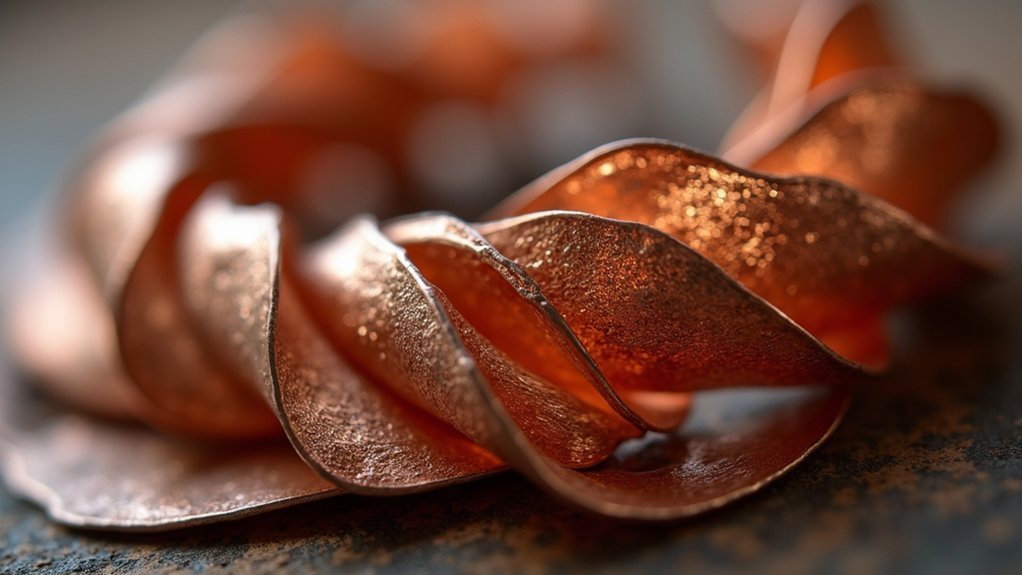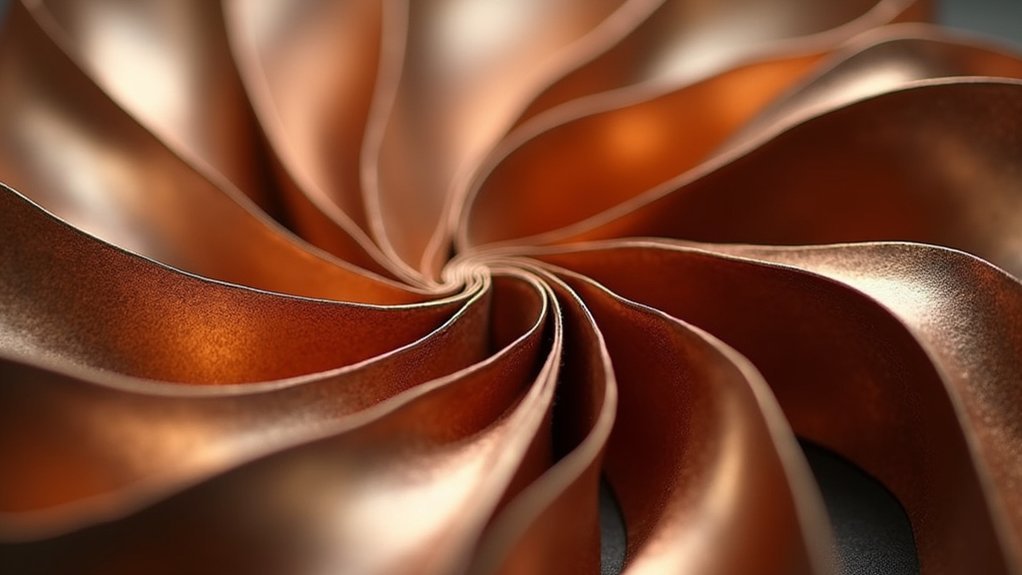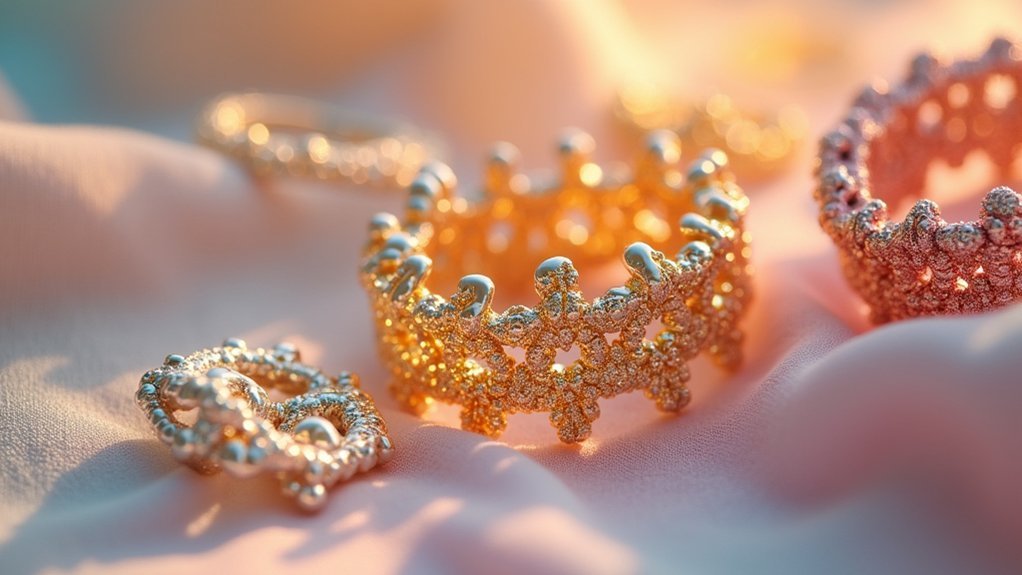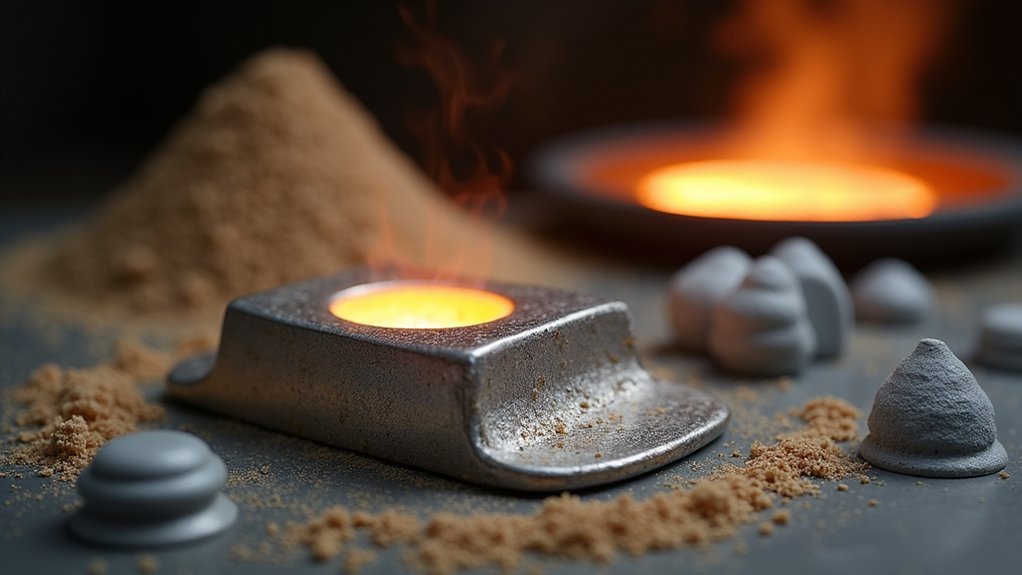You’ll master copper jewelry’s most advanced techniques with the Rueger fold, which transforms flat sheets into dynamic sculptural forms through systematic folding and hammering. T-fold chasing combinations create organic textures by forming deep creases and adding intricate surface details that mimic natural veins. Advanced scoring techniques give you precise control over three-dimensional manipulation, using deliberate cuts to guide your final shapes. These methods require proper annealing and consistent practice to achieve sophisticated results that showcase your technical artistry.
Mastering the Rueger Fold for Dynamic Dimensional Forms

When you’re ready to push your foldforming skills beyond basic techniques, the Rueger Fold offers an exceptional pathway to creating dynamic dimensional forms that transform flat copper into sculptural jewelry elements.
This advanced fold forming method creates parallel folds that mimic natural forms like petals or waves, giving your copper jewelry exceptional visual impact.
Start by marking evenly spaced lines on your copper sheet to guarantee uniformity.
Precision in marking creates the foundation for successful Rueger folds, ensuring each crease develops with professional consistency and visual balance.
You’ll develop the folds through systematic folding, hammering, and annealing processes that emphasize copper’s remarkable plasticity.
Once you’ve formed initial folds, use steel tools to forge additional dimensionality and strength into your pieces.
With basic tools and consistent practice, you’ll master this technique while gaining deeper understanding of copper’s properties and building confidence for even more complex applications.
Creating Organic Textures Through T-Fold and Chasing Combinations
The T-fold technique revolutionizes how you’ll approach organic textures in copper jewelry by creating deep creases that transform flat metal into lifelike forms reminiscent of leaves, petals, and flowing water.
When you combine T-folds with chasing techniques, you’ll enhance dimensionality dramatically as chasing adds intricate surface details that mimic natural veins and textures.
You must anneal your copper properly before and after folding to maintain malleability, enabling more pronounced organic forms during the folding and chasing processes.
Experiment with varying pressure levels during chasing to produce diverse textures that enrich your piece’s organic quality.
Utilize chasing hammers and punches alongside T-folds to create unique patterns and surface details that elevate your copper jewelry’s overall aesthetic.
Advanced Scoring and 3D Manipulation for Sculptural Elements

While T-folds create impressive organic textures, advanced scoring techniques will release your copper’s sculptural potential by establishing precise control points that guide three-dimensional manipulation.
You’ll create deliberate cuts and grooves in your copper before folding, giving you greater control over the final shape and texture. Start by making paper models to visualize your intended sculptural elements before working with metal – this preliminary design tool helps refine your artistic vision.
Experiment with varied scoring depths to produce different folding characteristics and dimensional effects. Shallow scores create gentle curves, while deeper cuts allow sharp angles.
Combine your scoring with 3D manipulation techniques like twisting and curving to enhance visual complexity. This approach transforms flat copper sheets into intricate copper jewelry pieces that showcase both technical skill and artistic sophistication.
Frequently Asked Questions
What Finish for Copper Jewelry?
You’ll want to choose based on your desired look: patina for colorful blues and greens, polished for bright shine, textured for depth, antique for contrast, or protective clear coating.
What Is Copper Fold Forming?
You’ll manipulate flat copper sheets through folding, forging, and shaping techniques to create three-dimensional forms. This metalworking process exploits copper’s malleability, letting you craft textured jewelry pieces that often resemble organic, nature-inspired designs.
How to Fold a Copper Sheet?
First, anneal your copper sheet by heating it until it glows dull red. Place it on an anvil, then use a plastic mallet to gently create folds, experimenting with different techniques like T-folds for varied textures.
How to Fold Form Metal?
You’ll start by annealing your metal sheet to increase malleability. Create precise folds using a steel anvil, strike with plastic mallets, and experiment with scoring techniques to develop three-dimensional forms and textures.
In Summary
You’ve now explored three advanced foldforming techniques that’ll transform your copper jewelry from simple pieces into dimensional artworks. The Rueger fold creates striking geometric forms, while T-fold and chasing combinations bring organic textures to life. Advanced scoring opens up sculptural possibilities you hadn’t imagined before. Don’t expect perfection immediately—these techniques demand practice and patience. Keep experimenting with different copper gauges and fold angles. You’ll discover your own creative voice through these sophisticated metalworking methods.





Leave a Reply